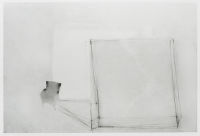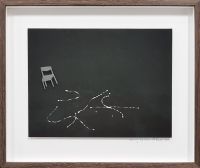"Twomb.0"
#03
pigment-based inkjet print on cardboard, wooden frame, engraved museum glass
signed, titled and dated (pencil)
Thermographic image of the heat trace of a chair that has been moved on the floor. The chair itself in the picture is engraved in the glass of the frame.
"Thermovision" combines photography and thermography in the process of creating the "thermovisions". Thermography is a process analogous to photography. While the camera records light waves, the thermograph depicts heat differences. The device consists of a heat sensor with a connected computer. The computer converts the sensor data into a visual image that can be viewed on the computer screen. Reusse photographs this screen image with a camera to obtain a negative from which he can have his cibachromes made. Shapes with low temperatures appear on the screen of the thermograph in bluish colours, high ones in shades between orange and white. For the thermograph to be able to reproduce something, an object does not necessarily have to be present. It is sufficient if it has left a warm aura. And this also applies to phenomena that are invisible from the outset, such as breathing air or a fart. Photo-historians will therefore classify a good part of "thermovisions" as "phantom images". While art historians are likely to place them in the context of "securing evidence".
(Prof. Gottfried Jäger, in: The Art of Abstract Photography)






